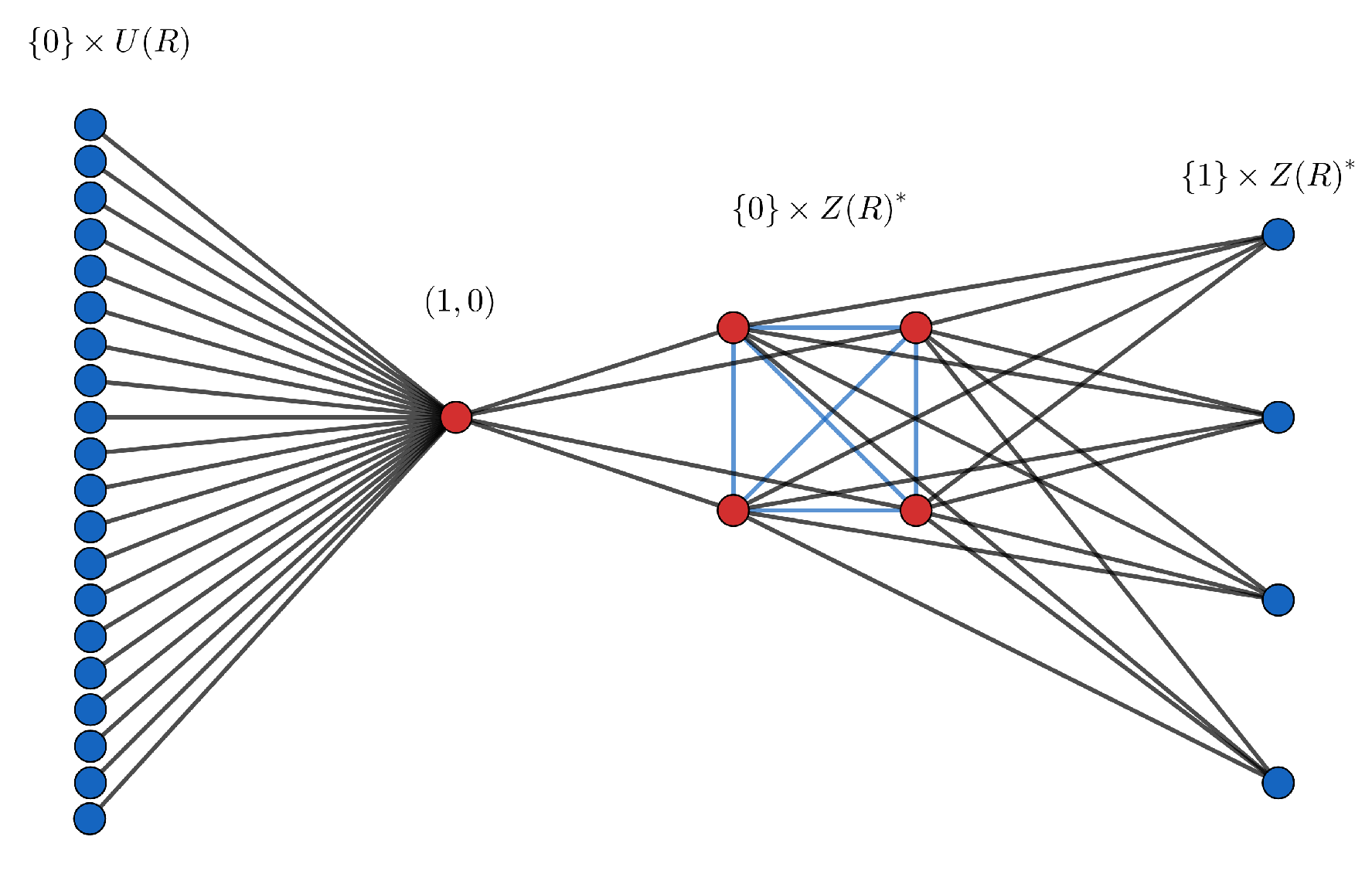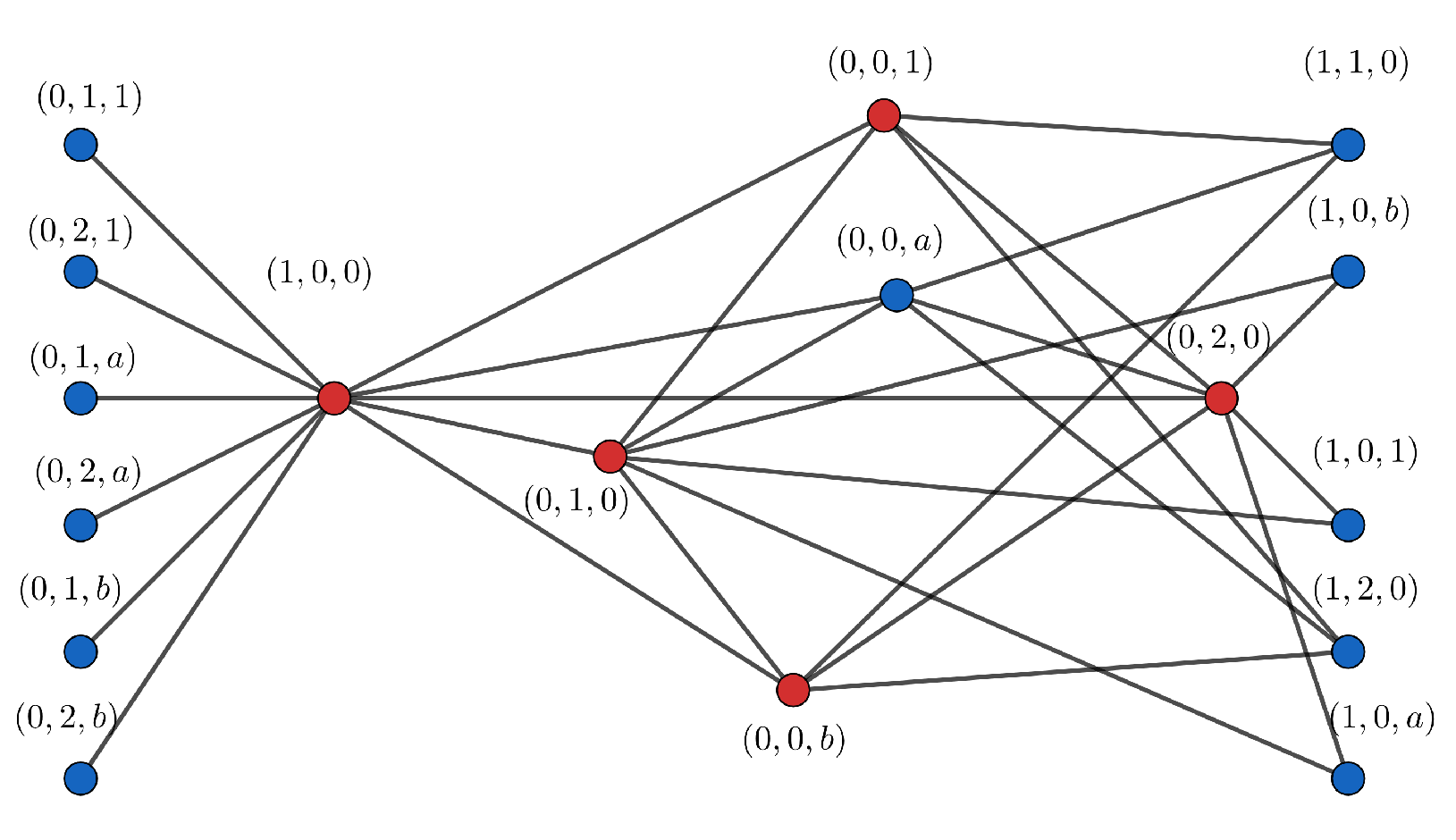On Global Offensive Alliance in Zero-Divisor Graphs
Abstract
:1. Introduction
2. Results
2.1. The Global Offensive Alliance Number of the Zero-Divisor Graph
- (1) for some .
- (2) , and for some prime integer p, and some positive integers n and r.
- (i)
- The inequality holds.
- (ii)
- If R has at least two units, then is an element of every alliance of .
- (i)
- We claim that the set is a global offensive alliance. Take ; if , then and (since is adjacent to ), while . On the other hand, if , then ; in this case, take such that . This shows that (since is adjacent to ), while .
- (ii)
- Let S be a global offensive alliance that does not contain the element . This implies that . In this way, is a global offensive alliance with vertices.
- (i) and , or
- (ii) .
- (1)
- ;
- (2)
- and if R is a reduced ring (i.e., a ring not containing non-zero elements x such that ).
- (i)
- ,
- (ii)
- ,
- (iii)
- (with , ),
- (iv)
- (with , ),
2.2. Rings with Small Global Offensive Alliance Number
- there exists , a pair of distinct vertices such that if then ,
- for , there are no edges connecting vertices of with vertices of ,
- if , then it is adjacent to both and .
3. Conclusions
Author Contributions
Funding
Institutional Review Board Statement
Informed Consent Statement
Data Availability Statement
Acknowledgments
Conflicts of Interest
References
- Kristiansen, P.; Hedetniemi, S.M.; Hedetniemi, S.T. Alliances in graphs. J. Comb. Math. Comb. Comput. 2004, 48, 157–177. [Google Scholar]
- Rodríguez-Velázquez, J.A.; Yero, I.G.; Sigarreta, J.M. Defensive k-alliances in graphs. Appl. Math. Lett. 2009, 22, 96–100. [Google Scholar] [CrossRef] [Green Version]
- Rodríguez-Velázquez, J.A.; Sigarreta, J.M. Global defensive k-alliances in graphs. Discret. Appl. Math. 2009, 157, 211–218. [Google Scholar] [CrossRef] [Green Version]
- Sigarreta, J.M.; Rodríguez-Velázquez, J.A. On defensive alliances and line graphs. Appl. Math. Lett. 2006, 19, 1345–1350. [Google Scholar] [CrossRef] [Green Version]
- Yero, I.G.; Rodríguez-Velázquez, J.A. Boundary defensive k-alliances in graphs. Discret. Appl. Math. 2010, 158, 1205–1211. [Google Scholar] [CrossRef] [Green Version]
- Yero, I.G.; Bermudo, S.; Rodríguez-Velázquez, J.A.; Sigarreta, J.M. Partitioning a graph into defensive k-alliances. Acta Math. Sin. Engl. Ser. 2010, 26, 73–82. [Google Scholar] [CrossRef] [Green Version]
- Favaron, O.; Fricke, G.; Goddard, W.; Hedetniemi, S.; Hedetniemi, S.; Kristiansen, P.; Skaggs, R. Offensive alliances in graphs. Discuss. Math. Graph Theory 2004, 24, 263–275. [Google Scholar] [CrossRef]
- Rad, N.J. A note on the global offensive alliances in graphs. Discret. Appl. Math. 2018, 250, 373–376. [Google Scholar] [CrossRef]
- Bermudo, S.; Rodríguez-Velázquez, J.A.; Sigarreta, J.M.; Yero, I.G. On global offensive k-alliances in graphs. Appl. Math. Lett. 2010, 23, 1454–1458. [Google Scholar] [CrossRef] [Green Version]
- Brigham, R.C.; Dutton, R.D.; Haynes, T.W.; Hedetniemi, S.T. Powerful alliances in graphs. Discret. Math. 2009, 309, 2140–2147. [Google Scholar] [CrossRef] [Green Version]
- Shafique, K.H. Partitioning a Graph in Alliances and Its Application to Data Clustering. Doctoral Dissertation, University of Central Florida, 4000 Central Florida Blvd, Orlando, FL, USA, 2004. [Google Scholar]
- Flake, G.W.; Lawrence, S.; Giles, C.L. Efficient identification of web communities. In Proceedings of the Sixth ACM SIGKDD International Conference on Knowledge Discovery and Data Mining, Boston, MA, USA, 20–23 August 2000; pp. 150–160. [Google Scholar]
- Haynes, T.; Knisley, D.; Seier, E.; Zou, Y. A quantitative analysis of secondary RNA structure using domination based parameters on trees. BMC Bioinform. 2006, 7, 1–11. [Google Scholar] [CrossRef] [Green Version]
- Powel, M. Alliance in graph. In Proceedings of the 255th of the USA Military Academy, Army Research Laboratory, Aberdeen Proving Ground, Harford County, MD, USA, 2004; pp. 1350–1415. [Google Scholar]
- Fernau, H.; Rodríguez, J.A.; Sigarreta, J.M. Offensive r-alliances in graphs. Discret. Appl. Math. 2009, 157, 177–182. [Google Scholar] [CrossRef] [Green Version]
- Rodriguez-Velazquez, J.A.; Sigarreta, J.M. Global alliances in planar graphs. AKCE Int. J. Graphs Comb. 2007, 4, 83–98. [Google Scholar]
- Rodríquez-Velázquez, J.A.; Sigarreta, J.M. Offensive alliances in cubic graphs. Int. Math. Forum 2006, 1, 1773–1782. [Google Scholar]
- Sigarreta, J.M.; Rodríguez, J.A. On the global offensive alliance number of a graph. Discret. Appl. Math. 2009, 157, 219–226. [Google Scholar] [CrossRef] [Green Version]
- Rodríguez-Velázquez, J.A.; Sigarreta, J.M. Global offensive alliances in graphs. Electron. Notes Discret. Math. 2006, 25, 157–164. [Google Scholar] [CrossRef]
- Redmond, S.P. On zero-divisor graphs of small finite commutative rings. Discret. Math. 2007, 307, 1155–1166. [Google Scholar] [CrossRef] [Green Version]
- Anderson, D.F.; Axtell, M.C.; Stickles, J.A. Zero-divisor graphs in commutative rings. In Commutative Algebra; Springer: New York, NY, USA, 2011; pp. 23–45. [Google Scholar]
- Beck, I. Coloring of commutative rings. J. Algebra 1988, 116, 208–226. [Google Scholar] [CrossRef]
- Anderson, D.F.; Livingston, P.S. The zero-divisor graph of a commutative ring. J. Algebra 1999, 217, 434–447. [Google Scholar] [CrossRef] [Green Version]
- Smith, N.O. Planar zero-divisor graphs. Int. J. Commut. Rings 2003, 2, 177–188. [Google Scholar]
- AbdAlJawad, E.E.; Al-Ezeh, H. Domination and Independence Numbers of Γ(Zn). Int. Math. Forum 2008, 11, 503–511. [Google Scholar]
- Muthana, N.; Mamouni, A. On defensive alliance in zero-divisor graphs. J. Algebra Its Appl. 2020, 20, 2150155. [Google Scholar] [CrossRef]




Publisher’s Note: MDPI stays neutral with regard to jurisdictional claims in published maps and institutional affiliations. |
© 2022 by the authors. Licensee MDPI, Basel, Switzerland. This article is an open access article distributed under the terms and conditions of the Creative Commons Attribution (CC BY) license (https://creativecommons.org/licenses/by/4.0/).
Share and Cite
Juárez Morales, R.; Reyna Hernández, G.; Rosario Cayetano, O.; Romero Valencia, J. On Global Offensive Alliance in Zero-Divisor Graphs. Mathematics 2022, 10, 298. https://doi.org/10.3390/math10030298
Juárez Morales R, Reyna Hernández G, Rosario Cayetano O, Romero Valencia J. On Global Offensive Alliance in Zero-Divisor Graphs. Mathematics. 2022; 10(3):298. https://doi.org/10.3390/math10030298
Chicago/Turabian StyleJuárez Morales, Raúl, Gerardo Reyna Hernández, Omar Rosario Cayetano, and Jesús Romero Valencia. 2022. "On Global Offensive Alliance in Zero-Divisor Graphs" Mathematics 10, no. 3: 298. https://doi.org/10.3390/math10030298
APA StyleJuárez Morales, R., Reyna Hernández, G., Rosario Cayetano, O., & Romero Valencia, J. (2022). On Global Offensive Alliance in Zero-Divisor Graphs. Mathematics, 10(3), 298. https://doi.org/10.3390/math10030298





